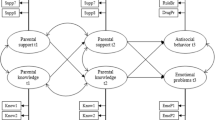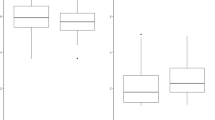Abstract
Parental monitoring has long been stressed as an important parenting practice in reducing adolescents’ susceptibility to depressive symptoms. Reviews have revealed, however, that measures of monitoring have been confounded with parental knowledge, and that the role of adolescent disclosure has been neglected. In the present study, adolescents (N = 2,941; 51.3% female) were surveyed each year from grades 9–12. To disentangle parenting factors, bidirectional associations among parental knowledge, adolescent disclosure, and parental monitoring (i.e., solicitation and control) were examined. Higher parental knowledge was associated with lower adolescent depressive symptoms over time. Adolescent disclosure and parental control also predicted lower adolescent depressive symptoms indirectly through knowledge. Conversely, higher adolescent depressive symptoms predicted lower parental knowledge, adolescent disclosure, and parental solicitation over time, highlighting the bidirectional nature of associations among parenting factors and adolescent depressive symptoms. Importantly, these effects were invariant across gender and grade, suggesting that interventions can be broadly based.


Similar content being viewed by others
References
Arbuckle, J. L., & Wothke, W. (1999). Amos 4.0 user’s guide. Chicago: SmallWaters.
Bentler, P. M. (1995). EQS structural equations program manual. Encino, CA: Multivariate Software.
Brown, B. B., Mounts, N., Lamborn, S. D., & Steinberg, L. (1993). Parenting practices and peer group affiliation in adolescence. Child Development, 64, 467–482.
Cohen, J. (1988). Statistical power analysis for the behavioral sciences (2nd ed.). NJ: Erlbaum.
Collins, N. L., & Miller, L. C. (1994). Self-disclosure and liking: A meta-analytic review. Psychological Bulletin, 116, 457–475.
Compass, B. E., Ey, S., & Grant, K. E. (1993). Taxonomy, assessment, and diagnosis of depression during adolescence. Psychological Bulletin, 114, 323–344.
Crouter, A. C., & Head, M. R. (2002). Parental monitoring and knowledge of children. In M.H. Bornstein (Ed.) Handbook of parenting: Vol 3. Being and becoming a parent (2nd ed., pp. 461–483). Mahwah, NJ: Erlbaum.
Devine, D., Kempton, T., & Forehand, R. (1994). Adolescent depressed mood and youth adult functioning: A longitudinal study. Journal of Abnormal Child Psychology, 22, 629–640.
Diagnostic and statistical manual of mental disorders: DSM-IV-TR. (2000). Washington, DC: American Psychiatric Association.
Feldman, B. J., Masyn, K. E., & Conger, R. D. (2009). New approaches to studying problem behaviors: A comparison of methods for modeling longitudinal, categorical adolescent drinking data. Developmental Psychology, 45, 652–676.
Finkenauer, C., Engels, R. C. M. E., & Meeus, W. (2002). Keeping secrets from parents: Advantages and disadvantages of secrecy in adolescence. Journal of Youth and Adolescence, 31, 123–136.
Fleming, C. B., Mason, A., Mazza, J. J., Abbott, R. D., & Catalano, R. F. (2008). Latent growth curve modeling of the relationship between depressive symptoms and substance use during adolescence. Psychology of Addictive Behaviors, 22, 186–197.
Fletcher, A. C., Steinberg, L., & Williams-Wheeler, M. (2004). Parental influences on adolescent problem behavior: revisiting Stattin and Kerr. Child Development, 75, 781–796.
Friendly, R. W., & Grolnick, W. S. (2009). Child adjustment and family dissolution: An examination of parental factors using self-determination theory framework. Journal of Divorce and Remarriage, 50, 66–80.
Frijns, T., Keijsers, L., Branje, S., & Meeus, W. (2010). What parents don’t know and how it may affect their children: Qualifying the disclosure-adjustment link. Journal of Adolescence, 33, 261–270.
Frojd, S., Kaltiala-Neino, R., & Rimpela, M. (2007). The association of parental monitoring and family structure with diverse maladjustment outcomes in middle adolescent boys and girls. Nordic Journal of Psychiatry, 62, 296–303.
Gil-Rivas, V., Greenberger, E., Chen, C., & Lopez-Lena, M. M. Y. (2003). Understanding depressed mood in the context of a family-oriented culture. Adolescence, 38, 93–109.
Greenberger, E., & Chen, C. (1996). Perceived family relationships and depressed mood in early and late adolescence: A comparison of European and Asian Americans. Developmental Psychology, 32, 707–716.
Hawk, S. T., Hale, W. W., I. I. I., Raaijmakers, Q. A. W., & Meeus, W. (2008). Adolescents’ perceptions of privacy invasion in reaction to parental solicitation and control. Journal of Early Adolescence, 28, 583–608.
Hovanesian, S., Isakov, I., & Cervellione, K. (2009). Defense mechanisms and suicide risk in major depression. Archives of Suicide Research, 13, 74–86.
Hu, L., & Bentler, P. M. (1999). Cutoff criteria for fit indexes in covariance structure analysis: Conventional criteria versus new alternatives. Structural Equation Modeling, 6, 1–55.
Hyde, J. S., & Petersen, J. L. (2009). A longitudinal investigation of peer sexual harassment victimization in adolescence. Journal of Adolescence, 32, 1178–1188.
Jacobson, K. C., & Crockett, L. J. (2000). Parental monitoring and adolescent adjustment: An ecological perspective. Journal of Research on Adolescence, 10, 65–97.
Keijsers, L., Frijns, T., Brange, S. J. T., & Meeus, W. (2009). Developmental links with adolescent disclosure, parental solicitation, and control with delinquency: Moderation by parental support. Developmental Psychology, 45, 1314–1327.
Kerr, M., & Stattin, H. (2000). What parents know, how they know it, and several forms of adolescent adjustment: Further support for a reinterpretation of monitoring. Developmental Psychology, 36, 366–388.
Kerr, M., & Stattin, H. (2003). Parenting of adolescence: Action or reaction. In A. C. Crouter & A. Booth (Eds.), Children’s influence on family dynamics: The neglected side of family relationships (pp. 121–151). New York: Erlbaum.
Kerr, M., Stattin, H., & Burk, W. (2010). A reinterpretation of parental monitoring in longitudinal perspective. Journal of Research on Adolescence, 20, 39–64.
Kim, S. Y., & Ge, X. (2000). Parenting and adolescent depressive symptoms in Chinese American Families. Journal of Family Psychology, 14, 420–435.
Kline, Rex. B. (2005). Principles and practices of structural equation modeling (2nd ed.). New York: The Guildford Press.
Laird, R., & Marrero, M. (2010). Information management and behavior problems: Is concealing misbehavior necessarily a sign of trouble. Journal of Adolescence, 33, 297–308.
Lewinsohn, P. M., Hyman, H., Roberts, R. E., Seeley, J. R., & Andrews, J. A. (1993). Adolescent psychopathology: I. Prevalence of incidence of depression and other DSM-III-R disorders in high school students. Journal of Abnormal Psychology, 102, 133–144.
Radloff, L. S. (1977). The CES-D Scale: A self-report depression scale for research in the general population. Applied Psychological Measurement, 1, 385–401.
Sagrestano, L. M., Holmbeck, G. N., Paikoff, R. L., & Fendrich, M. (2003). A longitudinal examination of familial risk factors for depression among inner-city African American adolescents. Journal of Family Psychology, 17, 108–120.
Schafer, J. L., & Graham, J. W. (2002). Missing data: Our view of the state of the art. Psychological Methods, 7, 147–177.
Seligman, M. E. P. (1991). Learned optimism. New York: Knopf.
Shek, D. (2008). Parental behavioral control and parent-child relational quality predictors of perceived parental knowledge in Chinese adolescents in Hong Kong. The American Journal of Family Therapy, 36, 332–343.
Sobel, M. E. (1982). Asymptotic intervals for indirect effects in structural equation models. In S. Leinhard (Ed.), Sociological methodology (pp. 290–312). San Francisco: Jossey-Bass.
Soenens, B., Vansteenkiste, M., Luyckx, K., & Goossens, L. (2006). Parenting and adolescent problem behavior: An integrated model with adolescent self-disclosure and perceived parental knowledge as intervening variables. Developmental Psychology, 42, 305–318.
Statistics Canada (2001). Population by ethnic origin [on-line]. Available: http://www.12.statcan.ca.
Stattin, H., & Kerr, M. (2000). Parental monitoring: A reinterpretation. Child Development, 71, 1072–1085.
Steinberg, L., Fletcher, A. C., & Darling, N. (1994). Parental monitoring and peer influences on adolescent substance use. Pediatrics, 93, 1060–1064.
Steinberg, L., Mounts, N. S., Lamborn, S. D., & Dornbusch, S. M. (1991). Authoritative parenting and adolescent adjustment across varied and ecological niches. Journal of Research on Adolescence, 1, 19–36.
Waizenhofer, R. N., Buchanan, C. M., & Jackson-Newsom, J. (2004). Mothers’ and fathers’ knowledge of adolescents’ daily activities: Its sources and its links with adolescent adjustment. Journal of Family Psychology, 18, 348–360.
Willoughby, T., & Hamza, C. A. (2010). A longitudinal examination of the reciprocal effects among parenting behaviors, adolescent disclosure and problem behaviors. Journal of Youth and Adolescence. doi:10.1007/s10964-010-9567-9.
Author information
Authors and Affiliations
Corresponding author
Rights and permissions
About this article
Cite this article
Hamza, C.A., Willoughby, T. Perceived Parental Monitoring, Adolescent Disclosure, and Adolescent Depressive Symptoms: A Longitudinal Examination. J Youth Adolescence 40, 902–915 (2011). https://doi.org/10.1007/s10964-010-9604-8
Received:
Accepted:
Published:
Issue Date:
DOI: https://doi.org/10.1007/s10964-010-9604-8




